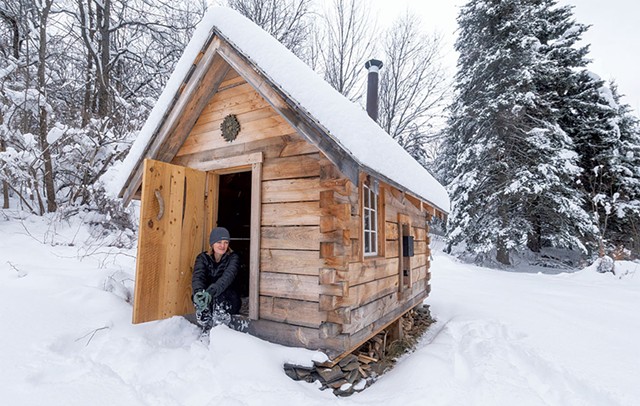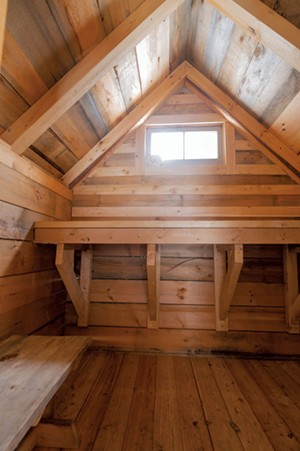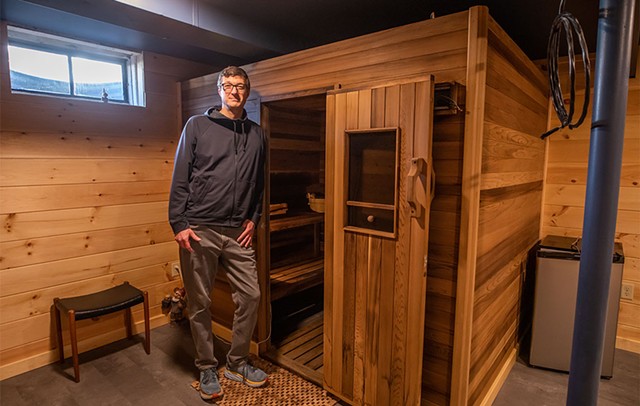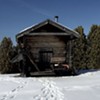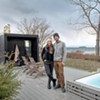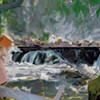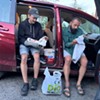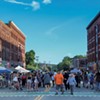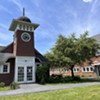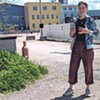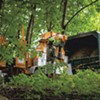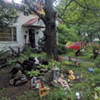Switch to the mobile version of this page.
Vermont's Independent Voice
- News
- Arts+Culture
- Home+Design
- Food
- Cannabis
- Music
- On Screen
- Events
- Jobs
- Obituaries
- Classifieds
- Personals
Browse News
Departments
Browse Arts + Culture
View All
local resources
Browse Food + Drink
View All
Browse Cannabis
View All
-
Business

Cannabis Company Could Lose License for Using…
-
Culture

'Cannasations' Podcaster Kris Brown Aims to 'Humanize'…
-
True 802

A Burlington Cannabis Shop Plans to Host…
-
Business

Judge Tosses Burlington Cannabiz Owner's Lawsuit
-
Health + Fitness

Vermont's Cannabis Nurse Hotline Answers Health Questions…
Browse Music
Browse On Screen
Browse Events
View All
Quick Links
Browse Classifieds
Browse Personals
-

If you're looking for "I Spys," dating or LTRs, this is your scene.
View Profiles
Special Reports
Pubs+More
Heat Wave: Vermonters Find Warmth and Wellness in Home Saunas
Published January 17, 2023 at 10:00 a.m. | Updated January 30, 2023 at 3:58 p.m.
Saunas were a Friday night tradition in Karen Larsen's Scandinavian community in northern Ontario. Heating in a fragrant wooden room, then plunging into the cold lake just outside, was a way to soothe the stresses of a busy week and connect with family members who shared the ritual.
Decades later, Larsen has found the same combination of comfort and tingling cold outside her home in Cabot, thanks to the new wood-fired sauna by her pond. Larsen and her partner, Will Ameden, like to relax by sweating in the log cabin and then dashing out to roll in the snow or dip in the pond.
Ameden and Larsen are following the traditional sauna process, which begins with intense, dry heat. After a time, users create bursts of steam by throwing dipperfuls of water on superheated rocks, then sprint out of the sauna for a cold shower or plunge in a lake.
"That transition from that superheated space into the water or a quick roll in the snow ... it definitely makes you feel alive," Larsen said.
Many share Larsen's sentiment. While Finns have been using saunas for thousands of years, the heated rooms took the U.S. by storm in the 1970s. Sauna practitioners tout their benefits to body and mind, and over the past 50 years, the rooms have become a staple at spas and health clubs.
When COVID-19 closed those clubs, home saunas gained popularity.
"It's interesting that it is once again a fad," said Eric Aho, a painter whose grandparents emigrated from Finland. Aho lives in Saxtons River but built his sauna 20 years ago at a friend's property in Walpole, N.H., where there is a pond. He saw other friends' interest in building home saunas pick up during the pandemic, an urge he attributes to the public's need for stress release and privacy.
New Hampshire sauna builder Bruce Ruotsala seconded Aho's observation. "I was a lot busier during the pandemic, and especially in Vermont," he said. Ruotsala, who sells sauna-building kits and also constructs custom saunas through his business, Finn Country Sauna Sales, added, "I saw a lot of outdoor saunas, often in second homes, and it was [for] people spending more time on the ski slopes or lakes."
To the initiated, the sauna is far more than a simple heated box. Many transplanted Scandinavians view the sauna as a cultural ritual that, when carried out under ideal conditions, imparts life-giving properties.
"Sweating is very important for humankind," said Eero Kilpi, a native of Finland who is president of the North American Sauna Society, based in Rye, N.Y.
As a lifelong sauna enthusiast, Kilpi strives to share traditional sauna do's and dont's in an industry largely disconnected from the traditional roots of the practice.
"It's been an uphill battle," he said.
On Kilpi's "do" list: Heat with wood if you can, because that's more authentic. He frowns on more convenient alternatives, such as the popular Bluetooth-enabled electric heaters that you can turn on with a smartphone app just before your last ski run of the day so that the sauna's ready when you get home.
Do douse rocks with water to create steam. And do create a place outside the sauna to rest and even socialize with fellow sauna users afterward.
The proper pronunciation, Kilpi said, is SOW-na, not SAW-na.
Another emphatic "do": Respect that both heat and cold are central to the authentic sauna experience.
"Contrast therapy, hot and cold, and rest and hydration — that's the whole point," Kilpi said. "That's where you get the health benefits. But most of the people, particularly in the U.S., think that the sauna is some kind of a pre-exercise warm-up procedure."
Sauna proponents aren't the only ones who think that sitting in heat is good for you. The Mayo Clinic released a paper in 2018 that said sauna bathing could reduce high blood pressure and cardiovascular disease.
Lately, the health and beauty industry has been promoting infrared saunas, which use light to focus heat directly on your skin, instead of heating up the whole room. They provide a fast, economical heat alternative that is very different from the traditional full-body sauna experience.
Kilpi's verdict on that innovation: "Junk from China."
Finnish immigrants have long carried their tradition to climates with Scandinavia-like temperatures, such as Minnesota and northern New England, according to Devin Colman, the state architectural historian at the Vermont Division for Historic Preservation. Colman researched Vermont's sauna history several years ago and found that communities of Finns who settled in southern Vermont from around 1910 to the 1930s built log saunas on their farms.
"The Finns are the masters of log construction, and it's very distinctive," Colman said. "You're looking for a little building. If it's maybe 10 feet by 15 feet square, with a door at one end and a chimney pipe at the other, chances are it's a sauna."
These days, saunas come in all shapes and sizes. Ruotsala, whose great-grandparents emigrated from Finland, recently completed an elegant barrel-shaped sauna in South Hero that overlooks Lake Champlain. Most saunas in the U.S. are traditionally made of cedar or other softwoods. Ruotsala often imports red cedar from Estonia for his saunas, which cost between $8,000 and $15,000, usually including an electric heater.
Nils Shenholm has been custom-building saunas for his business, Solhem Sauna in Duxbury, since the 1980s. He said windows are essential.
"Part of the culture of sauna is the connection to the outdoors, the spirit of forest landscape," he said. Shenholm, like Kilpi, is a purist, and he has served on the board of the North American Sauna Society.
"Having a wood-fired sauna is by far the most authentic and traditional — and, as far as I'm concerned, is the best," Shenholm said. He builds a lot of saunas in resort areas and also sells sauna-building kits. He said he has three saunas under construction in Greensboro, two of them on Caspian Lake.
"Having something near water is key," he added. But not just any water; salt water and swimming pools, Shenholm said, are not suitable.
click to enlarge 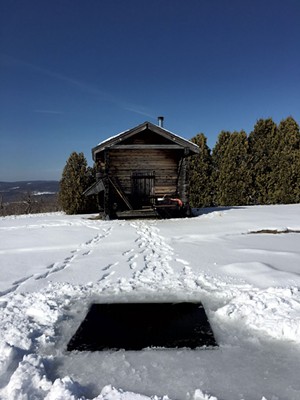

- Courtesy of Rachel Portesi
- Vermonter Eric Aho built this pondside sauna on a friend's property in Walpole, N.H.
"Going into chlorinated water after sauna doesn't make sense to me, because chlorine is poison, and salt water leaves a film on your skin," he said. "When you come out of sauna and rinse off with just water, your skin is as clean as it's ever going to get."
For those without a freshwater lake or pond nearby, a shower is the way to go. That's what Ameden has rigged up next to his own portable cedar sauna, which sits on a trailer on his Cabot farm, ready to be towed to the water's edge if the opportunity arises. Colman, the architectural historian, is putting the finishing touches on a sauna in his basement in Burlington, and he's got a shower next to it.
Saunas are generally heated to a temperature of 120 to 200 degrees. International residential building code stipulates that saunas be equipped with a thermostat that limits room temperature to no greater than 194 degrees, a rule that is unknown to many sauna users. Kilpi, however, said he was familiar with it.
"That seems enough," he said, adding that he's happiest at 180 to 185 degrees. "Your body is going to tell you when you've had enough."
Colman became familiar with saunas as a lakeside camp counselor in Minnesota, and he prefers a heat of 180 to 190 degrees. Some sauna users strive to tolerate ever-higher temperatures, but Colman rejects that approach.
click to enlarge 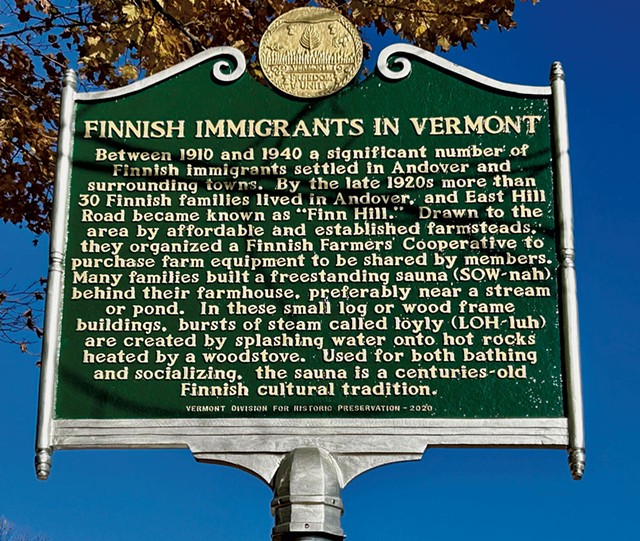

- Courtesy Of Dennis Gilkenson
- A roadside marker in Andover describing the bathing and social traditions of sauna
"It was never meant to be an endurance activity; I just don't see the point in that," he said. "It should be relaxing and calming."
Ameden had a neighbor custom-build two small woodstoves for the saunas he made. They allow users to feed wood into the stove from outside the building, keeping the wood and the smoke outside. He and Larsen sometimes emerge from her sauna in winter boots and bathrobes to make the short trek through the snow for a dip in the icy pond. There's a road on the other side of the pond, so they wear bathing suits.
"Nobody is staying in there to paddle around; it's a flash immersion," Larsen said. "Your skin is all tingly, and you make a run back for the sauna as fast as possible."
Kilpi approves.
"You're deep into the sauna culture when you do stuff like that," he said.
Related Stories
Got something to say?
Send a letter to the editor
and we'll publish your feedback in print!
More By This Author
About The Author

Anne Wallace Allen
Bio:
Anne Wallace Allen covers breaking news and business stories for Seven Days. She was the editor at the Idaho Business Review and a reporter for VTDigger and the Associated Press in Montpelier.
Anne Wallace Allen covers breaking news and business stories for Seven Days. She was the editor at the Idaho Business Review and a reporter for VTDigger and the Associated Press in Montpelier.
Speaking of...
-

Nest — Summer 2024
Jul 2, 2024 -

Settlement of a Federal Lawsuit Will Change How Real Estate Agents Are Paid
Jul 2, 2024 -

Richard Alther’s Lakeside Home Is a Memorial to His Own History — and Vermont’s
Jul 2, 2024 -

Porch Song: How Vermonters Take It Outside in the Summertime
Jul 2, 2024 -

Sparkle Barn and New Boutique Lodging Bring Vibrant Design to Wallingford
Jul 2, 2024 - More »
Comments
Comments are closed.
From 2014-2020, Seven Days allowed readers to comment on all stories posted on our website. While we've appreciated the suggestions and insights, right now Seven Days is prioritizing our core mission — producing high-quality, responsible local journalism — over moderating online debates between readers.
To criticize, correct or praise our reporting, please send us a letter to the editor or send us a tip. We’ll check it out and report the results.
Online comments may return when we have better tech tools for managing them. Thanks for reading.
- 1. Richard Alther’s Lakeside Home Is a Memorial to His Own History — and Vermont’s Home Tours
- 2. Settlement of a Federal Lawsuit Will Change How Real Estate Agents Are Paid Real Estate
- 3. Nest — Summer 2024 Nest
- 4. State Architectural Historian Devin Colman Steps Down — and Into a New Role Architecture
- 5. Sparkle Barn and New Boutique Lodging Bring Vibrant Design to Wallingford Interior Design
- 6. Porch Song: How Vermonters Take It Outside in the Summertime Architecture
- 7. Gardening Consultant Maggie Herskovits Celebrates Urban Plant Life Gardens & Landscapes
- 1. Settlement of a Federal Lawsuit Will Change How Real Estate Agents Are Paid Real Estate
- 2. Sparkle Barn and New Boutique Lodging Bring Vibrant Design to Wallingford Interior Design
- 3. State Architectural Historian Devin Colman Steps Down — and Into a New Role Architecture
- 4. Richard Alther’s Lakeside Home Is a Memorial to His Own History — and Vermont’s Home Tours
- 5. Porch Song: How Vermonters Take It Outside in the Summertime Architecture
























